NRL power rankings: Who are the top props in the NRL?
IT’S hard to win anything without a good pair of front-rowers. We’ve run the eye on all the competition’s big men in the latest instalment of our NRL power rankings.
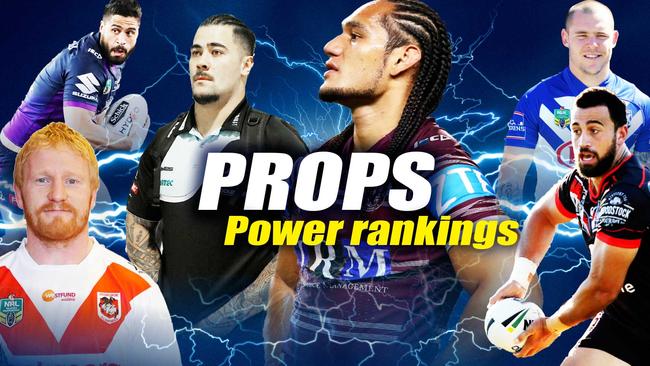
Teams
Don't miss out on the headlines from Teams. Followed categories will be added to My News.
TRIES and line breaks and fancy passes and all that might be what gets the headlines and the highlights and the fans through the gates, but on some level rugby league boils down to big fellas running into other big fellas as hard as they can.
It might cliche at this point, but if a team doesn’t have a quality pack of middle forwards they aren’t going anywhere. More often than not, success begins and ends up the guts.
In the second round of our NRL power rankings, we’ve run the eye over every starting prop duo in the NRL and ranked the lot of them according to their prowess as a duo, not merely as individuals.
Some of these spots are still up for grabs and could be subject to change.
HOOKERS: Who are the top dummy halves in the NRL?
SALARY CAP: Roosters hire former auditor
16) Thomas Burgess and George Burgess — South Sydney Rabbitohs
There’s a tendency to paint the Burgess twins with the same brush but Tom was effective enough in 2017 without being spectacular.
He ran for 113 metres per game in 41 minutes of playing time, which is a respectable return for a starting prop.
It’s not quite career best numbers, but they’re handy enough, and he deservingly kept his place in the England side.
The main problem for Tom was handling errors — he made 18 over the course of the season and a few crucial mistakes down the stretch in the World Cup final cost England dearly.
While the Burgess brothers have become notorious for their poor handling, George only made six errors through the whole season.
The larger problem is his lack of production as the brilliant 2013 and 2014 seasons drift further and further away. George could only muster an average of 33 minutes per game in 2017 and his mark of 88 metres per game was his lowest sum since 2012.
George lost his place in the England team and by the end of the season was reduced to a bit part role for the Bunnies, making short cameos that amounted to little.
He may return to some better form with a full pre-season under his belt but if he doesn’t improve he may be relegated to reserve grade in favour of fiery youngster Zane Musgrove

15) Korbin Sims and Matt Lodge — Brisbane Broncos
Brisbane employ a forward pack greater than the sum of their parts. Apart from Josh McGuire, none of the middle forwards are expected to play big minutes each week.
As a result, while Sims averaged just 39 minutes and 73 metres per game in his first season with Brisbane, he was still an effective tool for Wayne Bennett and his presence was missed once he went down with a season-ending injury against Parramatta.
It’s hard to know what to expect from Matt Lodge given it’s two years since he played NRL football but there’s a reason Brisbane were so keen to sign him despite his troublesome history off the field.
Lodge was regarded as one of the best up-and-coming props in the league during his time with the Storm and Tigers and was one of the nominees for Queensland Cup player in the year after a strong season with Redcliffe. Lodge’s ability has never been in question, but he is unproven at the top level.
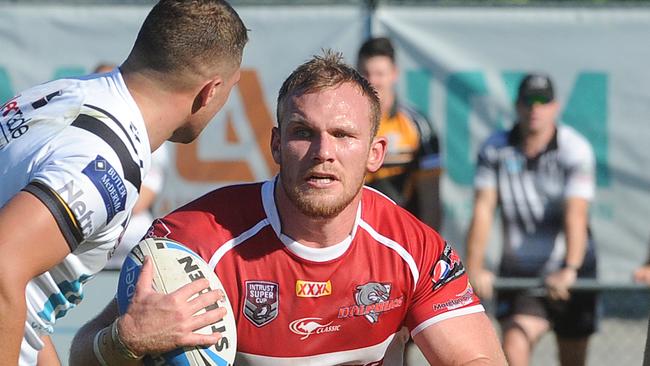
14) Tim Mannah and Kane Evans — Parramatta Eels
Parramatta skipper Mannah is still an important figure at Parramatta with his leadership and defence, but in terms of attacking production his role has been shrinking for some time. Mannah’s 34 minutes per game and 84 metres per game were his lowest marks in those categories since his debut season in 2009.
The Eels have a middle contingent filled with grafters rather than game-breakers, and Mannah is emblematic of that tendency.
In an effort to add a little more of a dynamic quality to the forwards, Brad Arthur has hit the market and brought in former Rooster Kane Evans.
A tremendously gifted athlete, Evans took a step back in 2017 as he fell behind Isaac Liu and Sio Suia Taukeiaho in the pecking order and battled injuries for much of the season.
A broken arm kept him out of much of Fiji’s World Cup campaign but given Arthur’s ability to bring the best out of players Evans could experience his long-awaited breakout season so long as he beats the likes of Daniel Alvaro (who grew into the starting role well in the back end of 2017) and Siosaia Vave for a starting spot.

13) Adam Blair and James Gavet — New Zealand Warriors
Adam Blair is a popular punching bag because of his chequered career with the Tigers and lack of big attacking numbers but he’s got plenty to offer a New Zealand side that requires a player with his skill set.
While Blair averaged just 74 metres per game last season, he sets a platform in other ways — namely by securing quick play the balls or using his passing skills or offloads to create a roll on for his fellow forwards.
Blair is also a strong contributor when it comes to line speed and should help lock up the middle of the field for the Warriors.
It remains to be seen just who will partner Blair up front, and if Simon Mannering will remain at the back of the scrum, but New Zealand at least have plenty of options. Albert Vete, Sam Lisone, Agnatius Paasi and Bunty Afoa will all be in contention but for our money James Gavet is the best fit for that spot.
Injury restricted Gavet to just 13 games last season but he was surprisingly productive, averaging 108 metres from 11.5 runs in 40 minutes of playing time.
Vete has struggled with injury and has seemingly fallen out of favour, Lisone is still a work in progress and Afoa appears to have been pegged as an edge backrower.
Paasi may yet take the spot from Gavet with the former Titan returning home after an injury-riddled year with Gold Coast, but we like the idea of Paasi’s dynamic running coming into the game after the opening quarter.
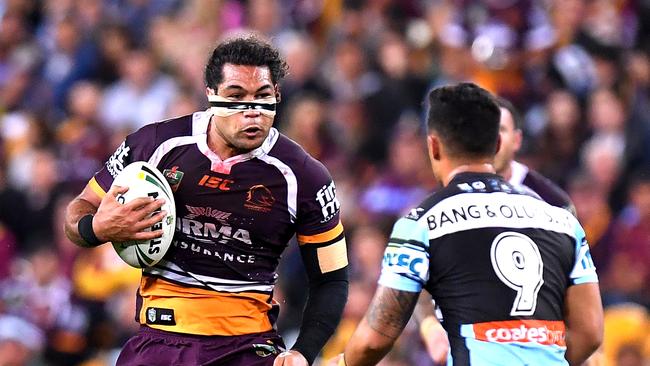
12) Jacob Lillyman and Daniel Saifiti — Newcastle Knights
What are you going to get from Jacob Lillyman in 2018? The same thing you got from Jacob Lillyman in 2017 — solid metres in the middle of the field, heaps of tackles, nothing spectacular but plenty of that solid stuff that every teams needs, the kind of stuff that wins games but not headlines.
Entering his 15th NRL season, Lillyman averaged 115 metres and 13.3 runs per game in 2017 — amazingly, both marks are career highs. During their years in the NRL’s underworld Newcastle have been forced to rely on unproven youngsters, overmatched bench players or veterans with an eye on retirement when it comes to middle forwards.
Not only is Lillyman the exact type of player the club needs to give their pack a little extra toughness, he’s a perfect mentor for the young forwards coming through the ranks.
One of those forwards is Daniel Saifiti, who is another of the prizes Newcastle have to show for their run of wooden spoons.
The Fijian international started 20 of his 23 games last year and emerged as one of the more promising middle forwards in the league, averaging 110 metres from 12.1 runs in 47 minutes of action.
Like the Knights themselves, Saifiti really hit his stride late in the year, running for over 125 metres in nine of his last 10 games. He’s still young, but there are high expectations around the 21-year old and he has the ability to meet them.
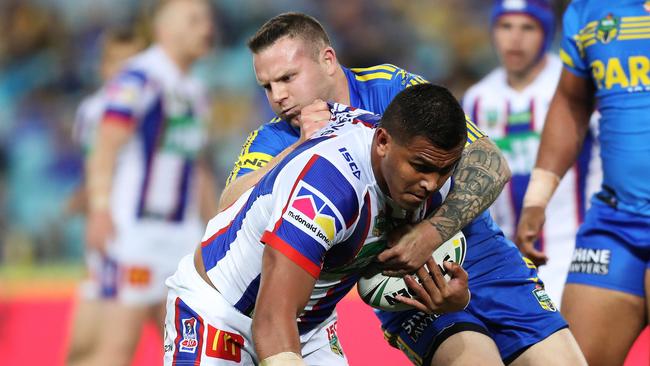
11) Ben Matulino and Russell Packer — Wests Tigers
Josh Reynolds might be the Tigers most high-profile recruit and Benji Marshall the most accomplished but Ben Matulino is their most important and possibly their best.
Injury blighted Matulino’s 2017 season as he managed just 16 games, but he has a rare pedigree as a front rower — in 2015 he averaged 144 metres per game and even in his diminished capacity last season he managed 109 metres per match.
If Ivan Cleary so chooses, Matulino could also be a real asset with his offloading — he popped 51 passes in 2015 but Stephen Kearney’s conservative style limited him to just 12 last season.
While Matulino posts the big numbers, Packer has far less frills associated with his game. Whole-hearted and hard-nosed, Packer will rarely put up big numbers but can grind out 40 good minutes without a worry and, like Matulino, played some of the best footy of his career under Cleary at the Warriors.
The two new boys form the bedrock of a revamped Tigers pack and along with Elijah Taylor, Sauaso Sue and Alex Twal they’ll form a contingent of middle forwards with a whole lot of upside.
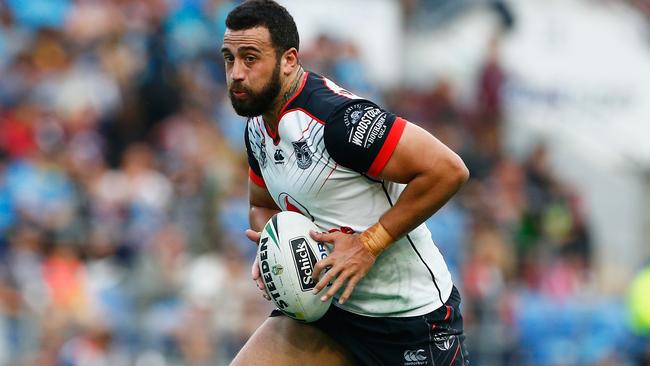
10) Jarrod Wallace and Leilani Latu — Gold Coast Titans
Gold Coast had as bad a year as possible in 2017 but they found a real ripper in Wallace, who thrived with more responsibility after switching from the Broncos. The Queensland Origin debutant broke the 100 metre mark in 15 of his 21 matches and put up some truly Taumalolovian performances at times — in the two clashes with his former club, Wallace ran for 252 metres from 26 carries and 197 metres from 20 carries respectively.
He also ran for 198 metres in the epic win over Melbourne in Round 10 and continued his good form as Gold Coast’s season collapsed around him in a haze of injuries, heavy defeats and Jarryd Hayne-related intrigue.
Wallace lacked support in the middle at most stages of the year as everyone bar Ryan James got injured, but he’s a real find and produced at a level that seemed beyond his capabilities.
Conversely, Latu had a difficult time after a breakthrough 2016 season.
The chopping and changing of the Penrith line up and the constant shifts to their middle rotation made Latu a casualty, and the Tongan international averaged a mere 35 minutes per game and could only break 100 metres once in 19 games.
But the 24-year old is better than those performances indicate, and should command heavier minutes up north. Light on his feet and a capable ballplayer, Latu is a smart pick for a strong comeback season.
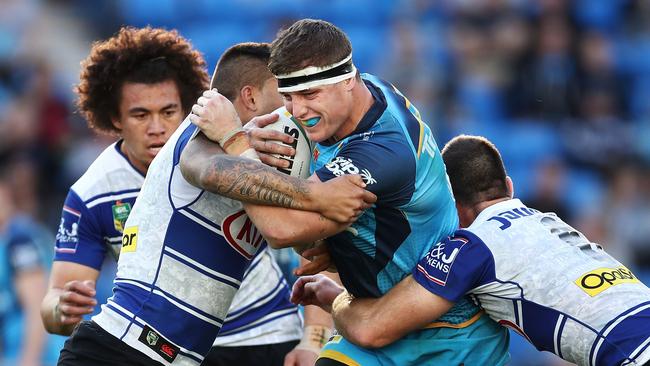
9) Junior Paulo and Shannon Boyd — Canberra Raiders
Shannon Boyd averaged 90 metres per game in 2016 and 2017. In 2016 he averaged 9.2 runs per game and in 2017 he averaged 9.9 runs per game. He averaged 35 minutes per game in 2016 and 39 in 2017. In 2016 he broke 100 metres gained on 10 occasions, in 2017 he did it nine times. For all intents and purposes, the two seasons were statistically identical, but in the former Boyd played for Australia and in the latter he was judged to have taken a step back. Boyd is yet to live up to his considerable potential and while he has the size to make an impact, improving his mobility and consistency is what can return him to the representative scene.
Junior Paulo enjoyed a fine season in his first full year in the capital. He posted career highs in terms of average minutes per game (54), average metres per game (129), average runs per game (13.8) and average tackles per game (19.4). He also passed 100 metres gained in 17 of his 23 matches and broke 150 metres gained seven times. Often he was playing something of a lone hand in the middle for Canberra, as the Green Machine struggled to get the best out of their middle forwards through the season. As with many Samoan stars, Paulo struggled during the World Cup but he’s the most important middle forward in Canberra and should be in the conversation for higher honours in 2018.
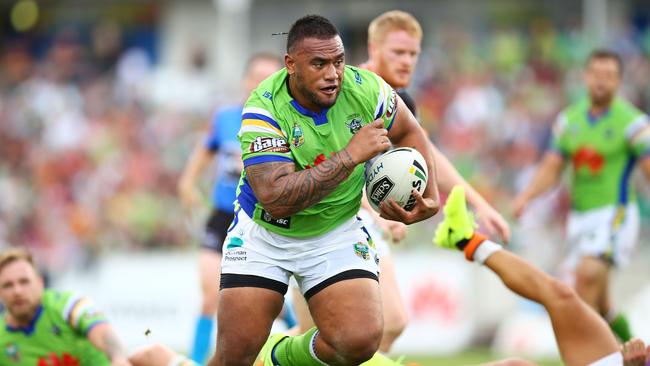
8) Jared Waerea-Hargreaves and Dylan Napa — Sydney Roosters
Napa got off to a great start in 2017, running for over 100 metres in nine of his first 12 matches and helping to set the tone for a Roosters pack that was greater than the sum of their parts. After several seasons on the periphery of Origin selection he made his mark in his debut series for Queensland, particularly in Game II, where he was one of the Maroons’ best. However, after his maiden rep campaign the fiery Napa hit the wall big time, as many Origin debutants do.
He ran for over 100 metres just once in his final nine games and managed just five runs for 44 metres in the preliminary final loss to North Queensland.
As a result, his stat line for the entire season fails to do his form justice (by the end of the season he averaged just 89 metres per game, his lowest mark since 2014), but given he has the experience of backing up an Origin campaign under his belt we can expect improved consistency from Napa in 2018.
According to the stat sheet, Waerea-Hargreaves had one of the better seasons of his career last year.
He averaged a very respectable 126 metres per game and seemed to be finishing the year in grand style after he played one of his best matches in several years against Brisbane in the first week of the finals.
However, despite some tough talk in the lead-up, Waerea-Hargreaves fell as flat as Napa, managing seven runs for 61 metres. Similarly, in a key showdown with Melbourne in Round 23 he could only muster 12 runs for 85 metres.
Waerea-Hargreaves still has the ability and athleticism to make a real difference, and the Roosters pack is designed to not rely on any one man, but these failures to produce his best on the biggest stage, as well as an alarming habit of conceding penalties (his 28 were the second most in the league), stopped him from hitting top gear.

7) Reagan Campbell-Gillard and James Tamou — Penrith Panthers
Campbell-Gillard has been solid since he came into first grade but late in 2017 he exploded into spectacular form, becoming Penrith’s most damaging middle forward and leading the way for the Panthers as they once again made the second week of the finals.
He lifted his average runs per match from 9.8 in 2016 to 12.2 in 2017 and had some truly brilliant games like his 219 metre effort against the Cowboys in Round 23, which he then backed up with a 137 metre effort against the Raiders in a must-win match the following week before running for 161 metres in the loss to the Dragons in Round 25.
A 159 metre effort from 17 carries in the semi-final defeat to Brisbane, where he was one of the best players on the field, confirmed Campbell-Gillard’s rise and his Test berth was well deserved.
In contrast, Tamou had a rough time in his first season away from North Queensland. He averaged 102 metres per match, a world away from his peak of 158 per match in 2012 and his worst return since 2010.
Tamou seems to have vanished from representative calculations and may improve his play now he’s settled in, but he’s yet to find anything near his best Cowboys form.
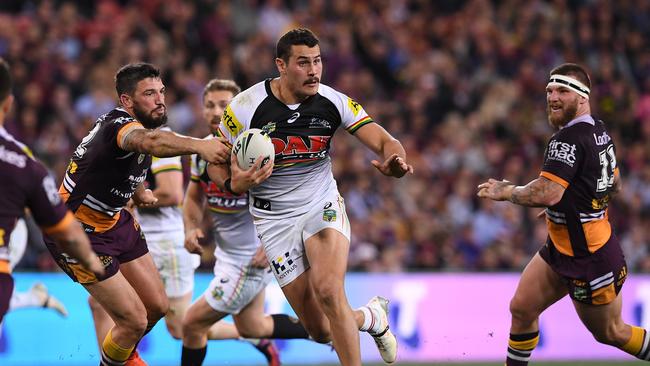
6) Andrew Fifita and Matt Prior — Cronulla Sharks
There are two Andrew Fifitas. There’s the Andrew Fifita who played in Origin I of 2017 and steamrolled the Maroons in every way a team can be steamrolled.
Fifita boasts athleticism that is rare among rugby league players in general, let alone props. He is fast and mobile but also strong and powerful, he has a low centre of gravity and seemingly sheds defenders with ease.
When it comes to talent, there are few who can match him.
But sometimes Fifita goes off the reservation. Instead of running north-south, he takes roaming east-west detours that accomplish little but derailing Cronulla’s attack.
His hands can be shaky at the best of times and fatal at the worst and his ongoing relationship with playing the ball correctly is one of the most torrid affairs in the sport.
When he’s consistent, there are few who are better, but that cannot always be so.
The solid, dependable Prior holds up his end well, apart from the odd handling error, and is the kind of player few fans covet but every club needs.
He wasn’t able to replicate his career year from 2016, but was still steady as a rock and will continue to be so for some time.
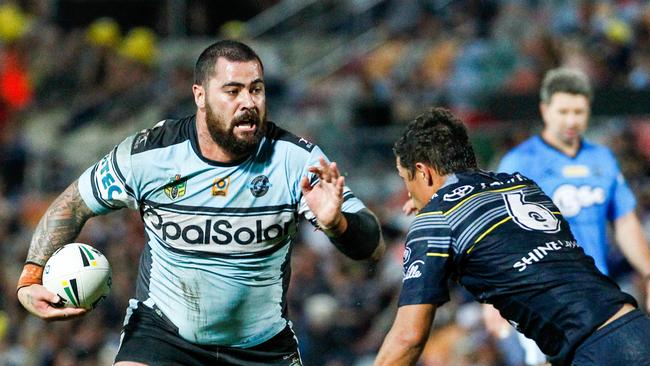
5) Martin Taupau and Addin Fonua-Blake — Manly Sea Eagles
Martin Taupau was simply superb through 2017, recording 152 metres per game on average, the 12th highest total in the competition.
This was despite playing 12 less minutes on average than the year before as he switched from lock back to prop. His 71 offloads led the league and opened a whole new world for Manly’s attack and Taupau was a key member of New Zealand’s World Cup campaign.
He is truly one of the best middle forwards in the world and perhaps the single best player on this list.
Darcy Lussick started as his front row partner in the latter part of 2017 and is certainly a solid and aggressive contributor, but if Manly were to start Addin Fonua-Blake they would boast twin terrors from the jump in each match.
Fonua-Blake made his Test debut for New Zealand after a strong sophomore season and, while he doesn’t have the offloading ability of Taupau, he’s a compact and dynamic option for Trent Barrett.
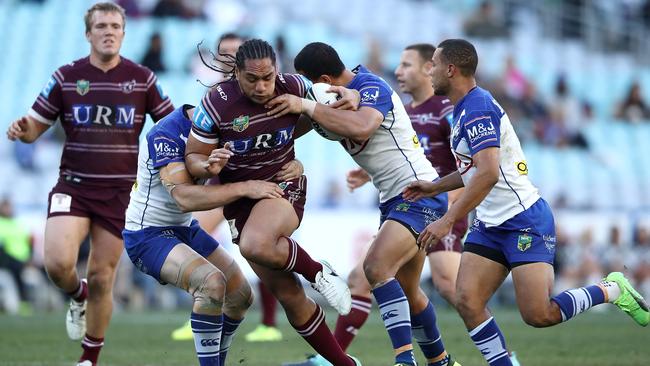
4) Jordan McLean and Matt Scott — North Queensland Cowboys
North Queensland could throw Jason Taumalolo and five battlers from the Camden Rams reserve grade out there and still have one of the best forward packs in the competition. Having one of the best props of the past decade and a player who recently claimed his Test debut is downright unfair. Jordan McLean has been on the cusp of rep football for several years and in 2017 he realised every bit of his considerable potential, and was often deployed as a wide running wrecking ball for the Storm. It remains to be seen if he stays in this role with the Cowboys but, regardless, he’s ready to become one of the premiere props in the game.
Matt Scott only managed two matches last season before a knee injury ended his season but despite his age we can expect a strong return to form. Scott was reportedly healthy enough to have played in the Grand Final if required and will have gotten a full pre-season under his belt. Given the prowess of Taumalolo and the rise of McLean, coupled with North Queensland’s auxiliary forwards like Shaun Fensom, Scott Bolton, John Asiata, Corey Jensen and Coen Hess, Scott can ease his way back into the form that has made him one of the best of his era.

3) Aaron Woods and David Klemmer — Canterbury Bulldogs
Aaron Woods is the reigning Dally M prop of the year and an automatic selection for NSW and Australia but he faces a difficult task in replacing James Graham at Canterbury.
While Woods exceeded Graham’s offensive production (Woods averaged 145 metres per game to Graham’s 102) he’s very different in style to the Englishman. Graham is blood and bone, a player who lives on extreme physical toughness and through force of will filters that through to the rest of the team. Woods is the more athletic player but does not have that same edge.
He’s a different player suited to a different style and, while he’s almost sure to make this move a success, the team’s style will have to adjust somewhat.
After a season-and-a-half at the back of the scrum, Klemmer will return to prop to replicate the partnership he and Woods established for Australia at the World Cup.
As a lock forward, Klemmer played the most minutes of his career and averaged 61 minutes of playing time last season. He made the most of it as well, averaging a very healthy 157 metres per game from 16.6 carries.
He was doing a fine job at lock, what makes his move back to prop exciting is the possibility of even more impact with his running game, albeit with a reduction in minutes. As we saw in last year’s Origin series, when Klemmer is wound up and allowed to wreak havoc without having to worry about playing extended minutes he becomes one of the most damaging players in the competition, and keep in mind he was already pretty effective.

2) Jesse Bromwich and Nelson Asofa-Solomona — Melbourne Storm
Old bull and young bull combine for an all-Kiwi combination down south which should ensure the Storm don’t lose a step after the departure of Jordan McLean. The time draws near when Nelson Asofa-Solomona will the best prop forward in rugby league. He’s large and will soon be in charge.
Asofa-Solomona gave Melbourne excellent punch off the bench last season and has an agility and footwork element to his game that defies his enormous size.
To cap it all off he is, with the greatest of respect, a really mean bastard when he’s on the field.
An explosive World Cup campaign for New Zealand confirmed his place as the code’s best young middle forward and if he takes over McLean’s spot upfront (although Tim Glasby could also be in with a shout) as expected, watch out.
On the other side of the 21-year old is Jesse Bromwich, who remains one of the best props in the world.
Bromwich endured a difficult opening half of 2017 as a cocaine incident resulted in his expulsion from the Kiwis’ World Cup squad and the revoking of the captaincy.
As a result of this tough start he averaged his lowest minutes per game since 2013 and his lowest metres per game since 2012.
But he rose to the occasion as the season drew to a close, turning in excellent performances in the epic win over the Roosters in Round 23 and passing 100 metres gained in each of the Storm’s final four matches.
With a full pre-season under his belt for the first time in years, Bromwich could experience a real lift in quality in 2018 - and when you consider that his 2017 was still pretty damn good that’s a scary proposition.
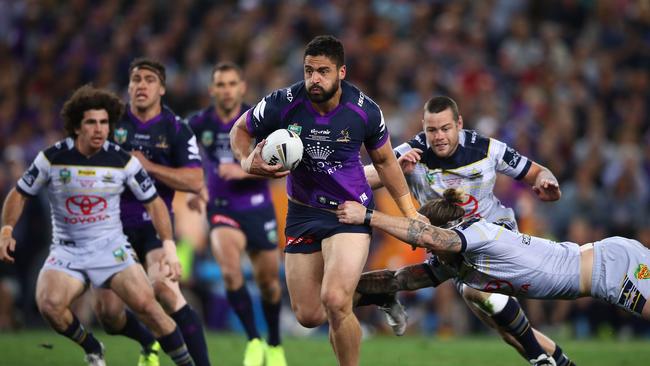
1) James Graham and Paul Vaughan — St George Illawarra Dragons
It’s rare that a player of James Graham’s prestige becomes available and in landing the English international the Dragons now boast the best front row duo in the league.
Over the past 12 months the Bulldogs turned Graham into much more of a pure battering ram, muzzling the crafty ball-playing that helped turn the former St Helens man into the best prop in the world after he joined the club in 2012.
They also cut his playing time to 51 minutes per match, the lowest of his Australian career. At 32 and with over 400 Super League, NRL and representative matches to his name it was safe to wonder if Graham was slowing down.
However, his excellent World Cup campaign for England disabused that notion entirely. Graham was in top form throughout the tournament, playing some of his best football in years in the twin defeats to Australia.

He was close to England’s best in the final and he struck up a fine combination with Gareth Widdop, which they can carry back to club level.
Allowing Graham to use his prodigious ball-playing skills can create uncertainty among the defenders, which opens doors for himself and others, and in Paul Vaughan, Graham has a perfect foil.
The dynamic former Raider was one of the best buys in the competition last season, can be expected to push for an Origin berth this season and to our eye completes the best prop duo in the league, a potent mix of power, speed, guile, skill, strength and toughness.


